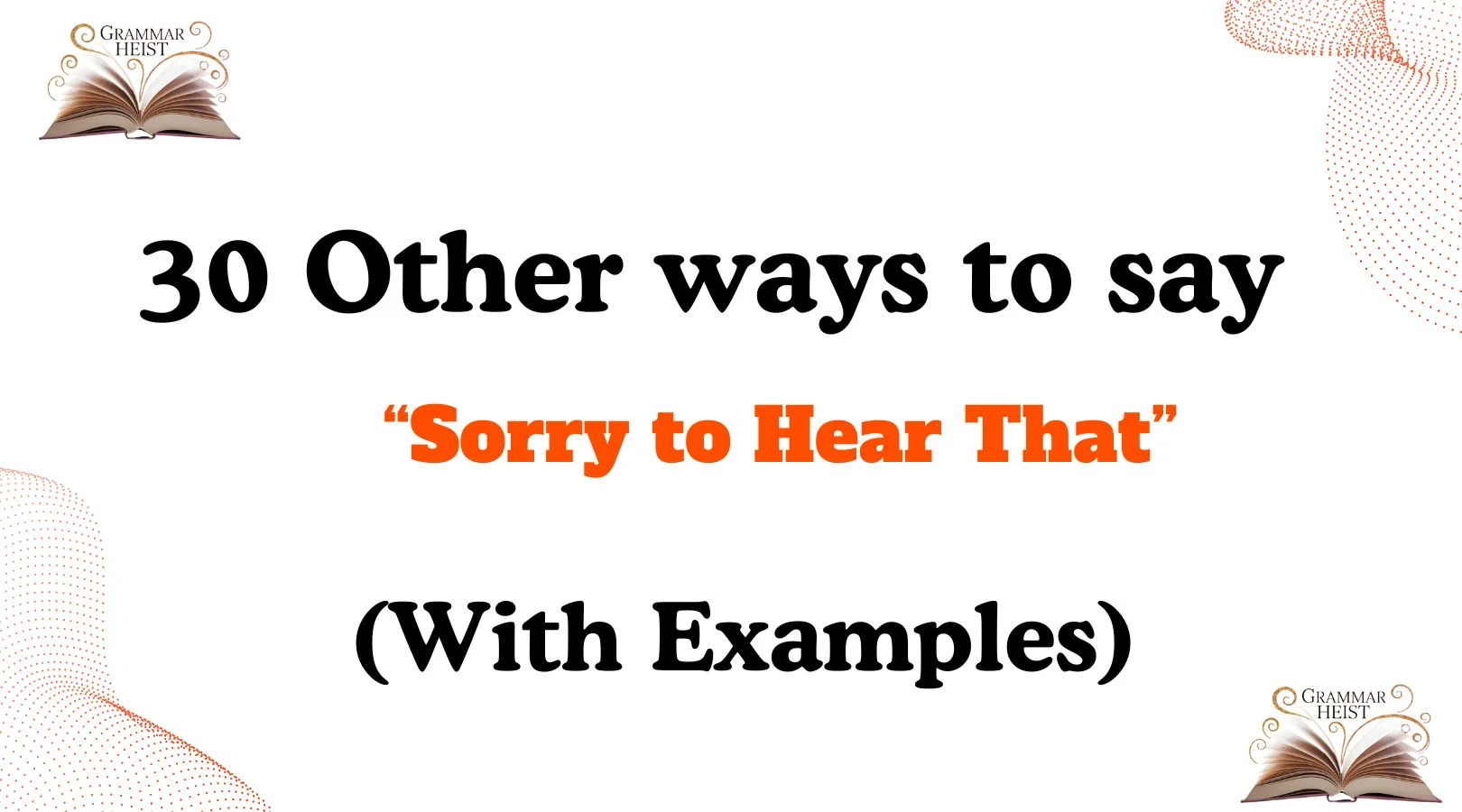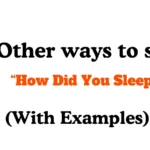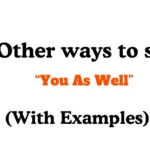Finding the right words to express care, sympathy, and understanding can be challenging, especially when someone shares bad news or is going through a tough time. Saying “Sorry to hear that” is polite and kind, but sometimes it can sound a bit overused or impersonal. That’s why learning other ways to say “Sorry to hear that” helps you express yourself with more warmth and empathy.
Whether you’re comforting a friend, responding to a colleague, or sending a thoughtful message online, these alternatives can help you sound more genuine, human, and emotionally aware.
What Does “Sorry to Hear That” Mean?
The phrase “Sorry to hear that” is a simple way to show sympathy or compassion when someone shares bad news. It’s often used to express concern, understanding, or support — even if you can’t fix the situation.
It’s a kind way to acknowledge another person’s pain and show that you care.
Is It Professional or Polite to Say “Sorry to Hear That”?
Yes, it is both professional and polite to say “Sorry to hear that.” In work settings, it’s commonly used in emails, messages, and meetings to express empathy without sounding too emotional.
However, using more personal and thoughtful alternatives can help your message stand out and feel more heartfelt — especially in close relationships or sensitive situations.
Pros and Cons of Saying “Sorry to Hear That”
Pros:
- Shows empathy and kindness
- Simple and easy to say
- Works in both formal and informal settings
Cons:
- Can sound repetitive or generic
- May feel too short for emotional conversations
- Doesn’t always express deep understanding
Synonyms For “Sorry to Hear That”
- That must be really tough
- I can’t imagine what you’re going through
- My heart goes out to you
- That sounds really hard
- I’m here for you
- That breaks my heart
- You’re in my thoughts
- That must be really overwhelming
- I’m deeply sorry you’re dealing with this
- That’s really upsetting to hear
- I wish I could make things better
- That must be so painful
- You don’t deserve this
- I’m thinking of you
- I can tell this means a lot to you
- You’ve been through so much
- I really feel for you
- That’s heartbreaking
- I’m so sorry this happened
- You’re not alone in this
- I completely understand why you feel that way
- That’s truly unfair
- I’m sending you my love
- I care about what you’re going through
- That’s got to be hard
- I’m sorry you’re hurting
- You’re handling this with so much strength
- It hurts me to know you’re struggling
- That’s really unfortunate
- You have my full support
1. That must be really tough.
Scenario: When someone shares something painful or stressful. Examples:
- That must be really tough for you right now.
- I can’t imagine how hard that must be.
- That must be a lot to deal with.
Tone: Compassionate and gentle.
Explanation: This phrase shows genuine empathy and acknowledges the person’s struggle without sounding robotic.
2. I can’t imagine what you’re going through.
Scenario: When the person is experiencing something beyond your understanding. Examples:
- I can’t imagine what you’re going through right now.
- That sounds really painful.
- You’re handling so much with strength.
Tone: Empathetic and respectful.
Explanation: Expresses humility and care, acknowledging that their experience is unique.
3. My heart goes out to you.
Scenario: When expressing deep sympathy. Examples:
- My heart goes out to you and your family.
- You’re in my thoughts.
- I’m truly sorry for what you’re facing.
Tone: Warm and heartfelt.
Explanation: Often used in emotional or serious situations to show deep concern.
4. That sounds really hard.
Scenario: For everyday empathy when someone shares difficulties. Examples:
- That sounds really hard, I’m sorry you’re going through that.
- It must be draining.
- That’s so tough to deal with.
Tone: Casual yet caring.
Explanation: Simple but authentic; works well in friendly or supportive conversations.
5. I’m here for you.
Scenario: When someone needs emotional support. Examples:
- I’m here for you, anytime.
- If you need to talk, I’m here.
- You don’t have to go through this alone.
Tone: Supportive and reassuring.
Explanation: Shows emotional availability and ongoing care.
6. That breaks my heart.
Scenario: When the situation is genuinely sad or moving. Examples:
- That breaks my heart to hear.
- It hurts to know you’re in pain.
- My heart hurts for you.
Tone: Deeply emotional.
Explanation: Stronger emotional response for close or personal connections.
7. You’re in my thoughts.
Scenario: Expressing sympathy or comfort, often in messages. Examples:
- You’re in my thoughts during this hard time.
- Thinking of you and sending love.
- You’ve been on my mind lately.
Tone: Gentle and considerate.
Explanation: Common in messages of support or condolence.
8. That must be really overwhelming.
Scenario: When someone shares stress or burnout. Examples:
- That must be really overwhelming to handle.
- It sounds like a lot to manage.
- You’re doing your best — that matters.
Tone: Understanding and supportive.
Explanation: Recognizes emotional exhaustion without judgment.
9. I’m deeply sorry you’re dealing with this.
Scenario: For serious or emotional situations. Examples:
- I’m deeply sorry you’re dealing with this pain.
- You don’t deserve this kind of hurt.
- I truly feel for you.
Tone: Formal and heartfelt.
Explanation: Suitable for professional or personal sympathy messages.
10. That’s really upsetting to hear.
Scenario: When someone shares disappointing or sad news. Examples:
- That’s really upsetting to hear about your job loss.
- I hate that this happened to you.
- It’s so unfair.
Tone: Empathetic and sincere.
Explanation: Acknowledges their emotions and validates their experience.
11. I Wish I Could Make Things Better
Scenario: When you feel helpless but want to show you care deeply.
Examples:
- I wish I could make things better for you.
- I’d do anything to ease your pain.
- I really wish I could help right now.
Tone: Tender and caring.
Explanation: This phrase expresses emotional support and a genuine desire to help, even when you can’t fix the situation.
12. That Must Be So Painful
Scenario: When someone shares something emotionally heavy or heartbreaking.
Examples:
- That must be so painful to go through.
- I can’t imagine how much that hurts.
- That’s really heartbreaking.
Tone: Deeply empathetic and sincere.
Explanation: This acknowledges their pain directly and validates their emotions, showing real compassion.
13. You Don’t Deserve This
Scenario: When someone experiences unfair or undeserved hardship.
Examples:
- You don’t deserve this at all.
- It’s so unfair that this happened to you.
- You deserve so much better.
Tone: Supportive and protective.
Explanation: This phrase helps the person feel validated and understood, especially when they feel wronged or hurt.
14. I’m Thinking of You
Scenario: When you want to remind someone that they’re in your thoughts.
Examples:
- I’m thinking of you today.
- You’ve been on my mind a lot lately.
- Just wanted to say I’m thinking of you and sending love.
Tone: Gentle and warm.
Explanation: This is a simple yet meaningful way to show ongoing care without intruding.
15. I Can Tell This Means a Lot to You
Scenario: When someone shares something that clearly matters deeply to them.
Examples:
- I can tell this means a lot to you.
- Your feelings are completely valid.
- I see how much this affects you.
Tone: Understanding and validating.
Explanation: Acknowledges emotional depth, showing that you’re listening and truly care.
16. You’ve Been Through So Much
Scenario: When someone has faced ongoing challenges or difficulties.
Examples:
- You’ve been through so much and still keep going.
- It’s okay to feel tired or upset.
- You deserve some peace after everything.
Tone: Encouraging and compassionate.
Explanation: Recognizes strength and resilience, offering emotional validation.
17. I Really Feel for You
Scenario: When someone shares personal struggles or sadness.
Examples:
- I really feel for you in this situation.
- That’s incredibly tough, I’m so sorry.
- You’re handling so much.
Tone: Empathetic and honest.
Explanation: Shows emotional connection and sincerity — perfect for both personal and professional empathy.
Read More:30 Other Ways to Say “In My Opinion” (With Examples)
18. That’s Heartbreaking
Scenario: When someone shares something truly sad.
Examples:
- That’s heartbreaking to hear.
- It breaks my heart to know that.
- That’s such a painful thing to go through.
Tone: Sorrowful yet caring.
Explanation: Expresses strong emotion in a soft and compassionate way.
19. I’m So Sorry This Happened
Scenario: When someone experiences loss, bad luck, or pain.
Examples:
- I’m so sorry this happened to you.
- No one should have to go through that.
- You didn’t deserve that outcome.
Tone: Warm and sympathetic.
Explanation: A classic but heartfelt phrase that feels personal and kind.
20. You’re Not Alone in This
Scenario: When someone feels isolated or unsupported.
Examples:
- You’re not alone in this — I’m here with you.
- You have people who care about you.
- You don’t have to go through this by yourself.
Tone: Reassuring and comforting.
Explanation: Reminds them they have support and that they are cared for.
21. I Completely Understand Why You Feel That Way
Scenario: When someone is emotional or venting.
Examples:
- I completely understand why you feel that way.
- Anyone in your shoes would feel the same.
- Your feelings make total sense.
Tone: Validating and gentle.
Explanation: Helps the other person feel heard and respected without judgment.
22. That’s Truly Unfair
Scenario: When someone experiences injustice or bad luck.
Examples:
- That’s truly unfair, I’m sorry you’re facing this.
- You didn’t deserve that kind of treatment.
- Life can be so unfair sometimes.
Tone: Honest and empathetic.
Explanation: Shows that you recognize the unfairness and side with their emotions.
23. I’m Sending You My Love
Scenario: When comforting someone from afar.
Examples:
- I’m sending you my love and strength.
- All my love to you during this time.
- Sending hugs and love your way.
Tone: Warm and affectionate.
Explanation: Great for messages, cards, or texts — gentle but deeply caring.
24. I Care About What You’re Going Through
Scenario: When you want to make your empathy more personal.
Examples:
- I care about what you’re going through and how you feel.
- You’re not just another story — this matters to me.
- I really care about you.
Tone: Personal and genuine.
Explanation: Shows active care and compassion, especially when others may not understand.
25. That’s Got to Be Hard
Scenario: When someone shares stressful or emotional experiences.
Examples:
- That’s got to be hard to manage.
- I can see why that’s so difficult.
- That must be a heavy load to carry.
Tone: Calm and supportive.
Explanation: Gentle acknowledgment of pain or hardship, without exaggeration.
26. I’m Sorry You’re Hurting
Scenario: When comforting someone in emotional pain.
Examples:
- I’m sorry you’re hurting so much right now.
- It’s okay to feel upset — I understand.
- I’m here if you need to talk.
Tone: Soft and compassionate.
Explanation: Focuses on their feelings rather than the event, showing emotional sensitivity.
27. You’re Handling This with So Much Strength
Scenario: When someone is struggling but showing resilience.
Examples:
- You’re handling this with so much strength and grace.
- You’re stronger than you realize.
- I admire how you’re coping with everything.
Tone: Encouraging and empowering.
Explanation: Shifts focus toward resilience and hope while still showing empathy.
28. It Hurts Me to Know You’re Struggling
Scenario: When expressing deep emotional empathy.
Examples:
- It hurts me to know you’re struggling like this.
- I wish I could take away your pain.
- I hate seeing you go through this.
Tone: Intimate and heartfelt.
Explanation: Strong emotional connection — best used for close relationships.
29. That’s Really Unfortunate
Scenario: When reacting to disappointing or sad news politely.
Examples:
- That’s really unfortunate — I hope things turn around soon.
- I’m sorry that happened to you.
- What a difficult situation.
Tone: Neutral yet empathetic.
Explanation: Works well for professional or formal conversations while still being kind.
30. You Have My Full Support
Scenario: When you want to assure someone you’re standing by them.
Examples:
- You have my full support in this.
- I’ll stand with you no matter what.
- I’m with you all the way.
Tone: Supportive and strong.
Explanation: Offers reassurance and loyalty — perfect for both emotional and professional situations.
🌿 Conclusion
Words have incredible power — they can soothe pain, build connection, and express empathy in ways that simple phrases sometimes can’t. Saying “Sorry to hear that” is kind, but exploring these 30 heartfelt alternatives allows you to communicate with depth, emotion, and authenticity.
Whether you’re comforting a friend, offering professional sympathy, or simply trying to show that you care — your words can make someone feel seen, supported, and valued. 💛

Emma Rose is a dedicated writing expert with a passion for helping others enhance their communication skills. With a strong background in grammar, language structure, and style, Emma empowers individuals to write with clarity, confidence, and impact. Her approach combines a keen attention to detail with a supportive, personalized touch, ensuring each person she works with improves and grows in their writing journey.













